The Maltese Townhouse – Typical characteristics to raise its value

Walking down a street in any village or town centre in Malta and Gozo, usually offers the sight of several older townhouses belonging to the pre-war or post-war era, sitting neatly in a row. Whichever period they originated from, they are usually characterised by a series of features which render them typical of these Mediterranean islands.
Once you become tempted to Townhouse in Malta purchase a townhouse in Malta of your own, in whichever part of the islands you fancy, do keep in mind that certain aspects of the townhouse are particularly appreciated and would make your investment that much more special.
Walking down a street in any village or town centre in Malta and Gozo, usually offers the sight of several older townhouses belonging to the pre-war or post-war era, sitting neatly in a row. Whichever period they originated from, they are usually characterised by a series of features which render them typical of these Mediterranean islands.
Once you become tempted to purchase a townhouse in Malta of your own, in whichever part of the islands you fancy, do keep in mind that certain aspects of the townhouse are particularly appreciated and would make your investment that much more special.
Here is what to look out for:
Small homes
Townhouses in Malta are generally small, having not more than two bedrooms. A townhouse with extra rooms is therefore extra special.

Wooden apertures
Wooden apertures in good and original condition are a bonus – the front door complete with brass knocker; the original ‘persjani’ alias louvred windows; the traditional wooden balcony. Wooden balconies were typically painted, cream, green, white, red or light blue, all colours which complement the natural limestone facade.
Shoe scrapers
A curiousity are the shoe scrapers sitting at one or both sides of the front doorstep. Made of wrought iron, these served to scrape goat and dog poo, or mud from the bottom of shoes before entering the house.
Wrought-iron front doors
Front door gates when included, are made out of wrought-iron and generally topped by a brass bar and brass handle.

Plaques depicting a religious saint
Apart from the door number (occasionally in brass) and a door name, facades were typically complemented by a ceramic or maiolica plaque depicting a religious saint, the Madonna & Child or the Holy Family.
Traditional floor tiles
Indoors, look for original floor tiles, handmade, colourful, intact and ornamental. The true Maltese townhouse usually boasted a different design and pattern of floor tile in each individual room. Today these original tiles can be reproduced at quite elevated prices, but of course nothing beats the original.
Wrought iron balustrades
Wrought iron balustrades are a staple feature along the indoor staircase.

Back garden
Most townhouses in Malta include a garden at the back. Some of the loveliest gardens can be reached via a roofed verandah shaded by vine on trellis. Gardens were not particularly large but some included a shed in the back and a separate toilet. The grander houses could have a garden large enough to allow the eventual inclusion of a pool. An alternative is the courtyard with its lone citrus tree.
Garden details
In the garden watch out for curiosities such as hand-hewn stone seating, sun dials, old plants and stone-cut planters. A well is usually present and the older ones would be have been dug out of the stone in the form of a bell (qanpiena) – a highly prized inclusion with ample water storage capacity.
Well-lit buildings
Townhouses in Malta are generally well-lit and some may sport a skylight overlooking the stairway, for daylight to spill into the house all day long.

Spiral staircase
The cherry on the cake would be the inclusion of a spiral staircase somewhere on the rear part of the house, perhaps leading up to the roof.

The above features are a great guideline on what to look for when checking for authenticity. Keep in mind that many townhouses that were threatened during the war have today been restored.
Townhouses in Malta are treasures and can be appreciated any time you look down a road and see a beautiful picture of a row of typical homes available in real estate in Malta. Fortunately many are still around to this day and have survived over time, however on the downside these houses in Malta are sometimes destroyed in favour of new developments. The Malta Planning and Environment Authority is continuing to implement protection measures for this type of property in Malta in certain locations, so as to preserve the heritage and legend of the islands.
